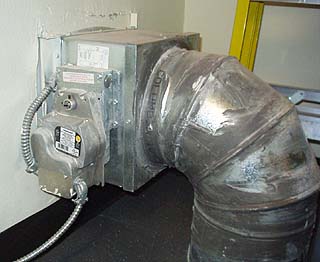
Surveys
AIA Awards
DJC.COM
November 20, 2003
Here's why projects need to be commissioned
Coffman Engineers

Adams
|
That's what I wondered when I walked on the site of a new elementary school in Western Washington. Being a mechanical design engineer by profession, I had some reservations about the tasks I was about to perform when given this commissioning assignment.
As the commissioning agent, it was my job to scrutinize the building to make sure that all systems were functioning properly and complied with the original design intent. That meant I was something like an external auditor or quality control specialist.
The facilities manager showed me around the school, explaining how the team of architect, engineer, mechanical and controls contractors had all worked together on the last several schools in the district. They had experienced few problems, he said, and the district was very happy with them. They had never hired a commissioning agent before — and only did so this time because the code had changed, mandating commissioning on all projects.
The Catch 22

Photo courtesy of Coffman Engineers
Fire/smoke dampers connected to exhaust ducts in a local elementary school had a manufacturing flaw that went undetected until the commissioning agent ran a function test.
|
This was to be my first exposure to the Catch 22 of commissioning — the paradox that commissioning is far easier and more enjoyable when you test all the systems and everything works perfectly. Your report provides a great testament to the integrity of the team. But it makes commissioning look like a waste of time and money.
On the other hand, if you find a lot of problems, you validate your role as a commissioning agent but it can be tough on the design and construction team. These are your peers, no doubt trying to do a good job while facing increasingly complex building systems. Being a design engineer, I could appreciate how they might feel having their work scrutinized.
The first items up for testing were the fire/smoke dampers. A fire/smoke damper is installed in an air duct where the duct passes through a smoke-barrier wall. It is intended to close automatically when the fire alarm is set off, eliminating the passage of smoke from one fire zone to another.
I had planned on witnessing the dampers' operation when the fire marshal checked them. But this particular jurisdiction does not have the manpower to inspect all devices, so they rely on the integrity of the contractors.
The sheet metal and electrical contractors assured me that all the dampers were functioning properly, but as the commissioning agent, I couldn't take anyone's word for anything. So I checked all of the dampers that were mounted horizontally in the school's corridor ceilings. Good news. We set off the extremely annoying fire alarm by spraying smoke on a smoke detector, and every one of the horizontally mounted dampers closed fully. To my relief, they also opened when the alarm was reset.
Problems found
Then we started on the vertically mounted dampers. Before functional testing even began, we discovered one damper that had no power connected to it. We turned to the balancer, the person who proportions the air in the duct system, making sure each room receives the correct quantity of air, ensuring that the system as a whole provides adequate outside air for ventilation. The balancer found another damper without power, and two that only opened to 45 degrees.
For this project, there was no way of telling by mere observation whether damper blades were in the open or closed position. Although there were indicators on the ends of the shafts, their orientation differed from damper to damper. And the contractor could not tell me which position the indicators were supposed to be in when the dampers were either open or closed. He insisted, however, that they were all in the open position.
Not good enough for me. I was required to verify that the dampers were fully open to start with, they closed fully upon initiation of the fire alarm, and they opened again when the alarm is reset. I asked that permanent lines be marked on the ends of each shaft, oriented parallel to the direction of the blades, so we could verify that they rotated fully. The request generated some skepticism. But in the end, all of the blades were marked.
We braced ourselves and set off the general fire alarm again, checking to see how each of the vertically mounted fire/smoke dampers performed.
The results were a shock.
Out of a total of 30 vertically mounted dampers, 12 had blades that didn't rotate fully due to problems with the damper itself. One didn't function at all due to an electrical glitch. And two mounted at wall grilles had blades obstructed by nearby electrical disconnects. Including the two dampers that had no power in the first place, 17 vertical smoke/fire dampers — or 57 percent — did not function properly.
Out of the total number of fire/smoke dampers, horizontally and vertically mounted combined, 17 out of 57 — or 30 percent — did not function properly. Of those dampers whose shafts did not rotate fully, we initially thought the blades were not closing completely. Upon inspection, we found that most of these dampers were obstructed in a way that their blades could not open fully, and hence the shaft only rotated 45 degrees when closing.
It would have been just as easy, however, for the obstruction to occur in a manner that prevented the blades from fully closing. If that had been the case, in the event of a fire, hundreds of children's lives could have been at risk.
Faulty screws
The majority of the dampers that failed were small, single-bladed models, and they all had the same design flaw. The blade was obstructed by screws attaching the damper sleeve to the duct. Where it appeared as though the dampers didn't fully close when the alarm was sounded, in fact they weren't fully opened when they were marked. Although the standard size of sleeve length was ordered, screws were installed as close to the end of the sleeve as possible and the smallest acceptable screw size was used, the damper had been manufactured in such a way that the blade got stuck on the screw when the damper tried to open.
The sheet metal contractor quickly set about fixing the fire/smoke dampers on the same day.
What's the moral of the story? NOT that the designers or contractors weren't doing their job. It's that nobody is able to anticipate everything that can possibly go wrong. It takes a third-party, objective viewpoint to try out everything and prove beyond a doubt that systems work (or don't work) properly. Which explains, in a way, why someone would take pleasure in going into this profession in the first place.
Connie Adams is a mechanical engineer and commissioning agent at Coffman Engineers in Seattle.
Other Stories:
- Today's buildings load up on technology
- Letting rainwater reign in the design process
- Church praises the benefits of adaptive re-use
- UW builds on design leadership training
- Science studies how architecture affects the brain
- China creates a park with environmental appeal
- How the Great Fire changed Seattle's architecture
- Architects play catch-up in the business world
- Designing with nature in the balance
- 12 keys to creating authentic people places
- Monorail to move urban design as well as people
- Water tower repairs borrow on building technology
- Technology takes center stage in performance halls
- Don't be violated — protect plans with copyrights
- Special dampers may shake up engineering field
- UW Allen Center fosters a culture of research
- Unwrapping modern building envelopes
- Lessons on sustainability, Scandinavian style
- Building a highrise on the fault line
- How to keep development from killing trees
- Rx for changing healthcare industry: Good design
- In hospitals, spending more can save money
- Muckleshoot project blends culture with design
Copyright ©2009 Seattle Daily Journal and DJC.COM.
Comments? Questions? Contact us.